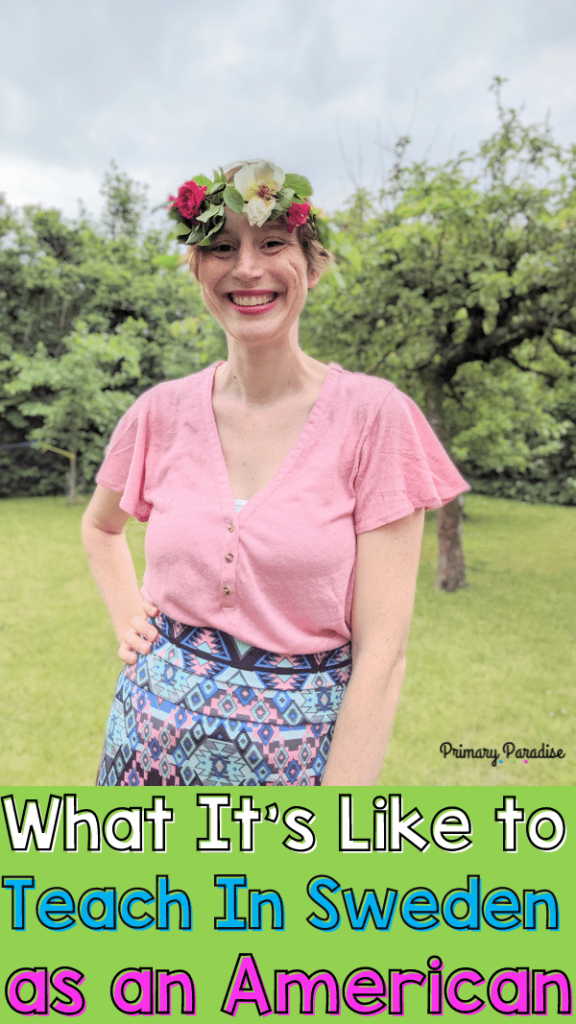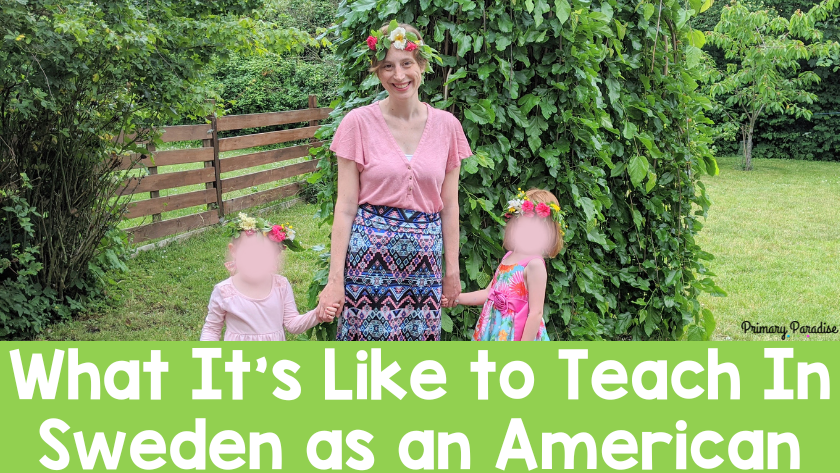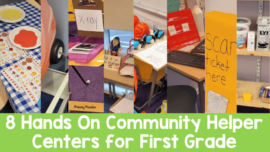Teaching in Sweden after teaching in the US has been an adjustment. In some ways, things are very similar, but in others, they are totally different. Here are some comparisons based on my personal experience as an American teacher who has taught in both the United States and Sweden.
My Experience
In order to make a fair comparison, it’s important to understand my experience. I was born and raised in New Jersey, and all of my experience of teaching in the US took place in the good ol’ garden state. (Yes, NJ is actually known as the garden state. It’s not all a mini New York.)
During my time teaching in the US, I student taught first grade for a year in one school. Then, I taught first grade for 2.5 years in a different county at a charter school in New Jersey. I then spent 6 months as a educational clerical assistant in another district. If you don’t know what that is, I didn’t really get it either. Basically, I was the assistant principal’s assistant (say that 10 times fast). I was in charge of attendance and truancy, I was the in house sub for pre-k to 8th grade, and I did pull out intervention for 1st-7th grade.
After 6 months, I moved to a new school where I taught 2nd for one year. Then 1st for 6 months before I decided to stay home with my oldest daughter who was a baby at that time. After a few years, I missed teaching very much. I applied to be a reading intervention teacher at another district mid-year. I got the job, and did that for the rest of that school year and the following school year.
Then, we had our third child and our family moved to Sweden. After our move, I took a year to get my International Baccalaureate certification since my only opportunities to teach would be at one of the IB schools in the area. A year later and I decided to apply for a PYP teaching position at my kids’ school, and I got the job as a grade 1 teacher.
So, all of that to say, I have taught in many school in New Jersey, but only one in Sweden. I do have friends and know educators in other schools in Sweden, but the following observations and comparisons are based on my personal experiences. I realize things do vary in the US and Sweden, of course. So, that being said, let’s get into it.
Dress Code
This was a huge adjustment for me! In NJ where I taught, we had pretty strict expectations for what was and was not okay to wear. And jeans were only allowed maybe once a month if you paid for a jeans pass.
In Sweden, things are much more laid back in terms of dress code. Jeans are common, and sneakers and comfortable footwear are the norm. Since most people are walking and biking to work, it just makes sense. Of course sometimes I decide to dress up more, but I love that it’s really up to me! This is not just teaching either. Most people dress pretty casually to work, whatever field they work in.
Lunch Time
In the US, typically children eat in the lunch room either with teachers taking turn monitoring lunch or with teaching assistance or lunch room workers monitoring the kids. In the districts where I taught, kids packed a lunch from home or could buy a hot meal from school. The meals tended to be pre-packaged foods served in packaged containers, so there was a lot of waste. Also, (and think think might have changed since covid in many places) meals had a cost, but some students could qualify for free or reduced lunch to make it more affordable.
Teachers had their own time/ space to eat. I typically would eat in the teacher’s room 1-2 times a week and then shovel my food in my mouth while I marked papers the other 3-4 days. In most of my school, teacher’s had about 30-40 minutes to have lunch on their own.
In Sweden, lunch is verrrry different and this is something I thought I wouldn’t like… but I actually love! Lunch is considered part of the learning day. Teachers and students all eat together. Balanced meals are served on real plates with glasses and silverware (even my 3 year old in preschool does this). Teachers serve the food. Children are taught to scrape their plate into a food waste bag for composting and then clean their spot when they’re done. Although eating with 25 first graders can be a bit loud at times, it’s also really nice most of the time! It feels like a big family meal.
Teachers also are guaranteed a 30 minute break/ lunch without kids every day as well while the kids are out on the playground.
Nurse Duties
Here’s one thing that I don’t love the Swedish way, although I have been informed this varies by school and area.
In the US, every school had a school nurse who would handle all sick kids. Tummy ache? Go to the nurse. Headache? The school nurse. Scraped knee? The nurse will fix you up! In fact, in one of my schools, I wasn’t even *allowed* to put a band-aid on a student for liability reasons.
In Sweden, there *is* a nurse at the school, but the school nurse is actually an extension of the regular healthcare system. They’re there to do health checks and give vaccines, mostly. However, if a child feels sick or bumps their head or scrapes their knee? That’s on the teacher to handle. Each teacher has a first aid kit for scrapes and cuts, and if a child is sick, the teacher is the one to contact the parents to pick them up. I will say, I have been told this varies a bit in school, but this has been my experience.
Sick Days
In NJ public schools, we had 10 sick days a year plus 2 “personal days”. These could roll over to the next year, but if you ran out, you were out. Also, personal days did not roll over, only sick days.
Everyone, including myself, only took these days if you were REALLY sick because you never know what’s going to happen and you didn’t want to run out. (Or, you might be saving them so you can have more time off when you had a baby in the future. ) If I was out, I did *have* emergency sub plans, but the expectation was that you sent in plans for the time you were out. I’ve heard of teachers in the hospital trying to put together sub plans or write report cards comments as they’re headed in for surgery.
In Sweden things work very differently. First, every worker has the right to take off if they’re sick whether you work as a waiter or a doctor or a teacher. Your job can’t legally ask you to work when you’re sick either. The first day is unpaid typically (this was not the case from March 2020- for 2 years), and then you receive about 80% of your salary.
The first 7 days that you’re sick, you don’t need to prove anything. After 7 days, you need a doctor’s note.
My FAVORITE thing about teaching in Sweden when it comes to needing days off is VAB or vård av barn (care of child). If your child is sick, you can take off to care for them. Paid.
As a mom of 3, I’ve only taken a few sick day for myself this year, but I’ve had to take several days off to VAB for my kids.
Of course, as a teacher, I still feel guilty taking off, and I still DO choose to write sub plans, but it’s SO nice to know that I don’t have to if I don’t want to. It’s also so nice to know that I don’t have to worry about being with my kids when they’re sick.
Parental Leave
Only a handful of US states had government funded maternity leave when I had my oldest. Luckily I lived in one. However, in order to get a much time as possible, I needed every day I could save. So, I worked until Friday and gave birth 2 days later on Monday.
In NJ in 2014, I received 6 weeks of leave at a reduced pay rate. I saved up my magical 10 sick days and used those to add another 2 weeks. Then, I took one more week of unpaid leave that thankfully I was granted because they could have said no. This got me to summer break, so I got another 2 months home (unpaid of course because it was summer). I went back to work when my daughter was 4 months old and still waking several times in the night. I was told over and over how lucky I was to have a full 4 months in the US. When I told Swedish friends about this, they were horrified that I had so little time and that it was mostly unpaid.
I sure wish I had some of my kids in Sweden! In Sweden, parents received 480 days of parental leave to be shared between the parents. (90 days are reserved for each parent, but the rest they can split as they wish.) Both parents (with the exception of right after a baby is born or adopted) can’t take parental leave at the same time. This means, parents can take plenty of time to bond with their new babies, and both parents share the responsibility.
When you’re on parental leave, you receive 80% of your pay, and some employers top that up during the first 18 months.
Also worth noting:
- Even if you aren’t employed, you still receive parental leave at a lower rate.
- Your parental leave doesn’t expire until your child is 8-12 (depending on the year they’re born). However, once they turn 4, you can only save a certain number.
- Even if your child wasn’t born in Sweden, if you are a resident you are eligible for parental leave after working for 1 year in Sweden. (This is based on he child’s age when they moved to Sweden.)
Recess
I’m sure it varies from state to state, but in the schools I taught in in NJ (and I taught in 4) my first graders only ever got ONE recess a day. Typically this was right before or after lunch and usually lasted about 20 minutes. I also was never encouraged to give my students extra recess (and in some schools it just wasn’t allowed due to schedules). Also, if it was rainy or below freezing, the kids were inside for indoor recess. This meant either sitting in the lunch room coloring or coming back to my classroom and playing games or doing puzzles. I was not a fan because it meant it was very hard for them to properly get their energy and wiggles out.
In Sweden, at least in my school, my students get 2 breaks outside everyday for a total of 50 minutes. And, it’s not unusual at all for teachers to give kids some extra time outside (if they’re willing to come out to watch them) on nice days. (Especially in the winter and fall, the sun basically disappears, so you soak up the good weather when you can!) If it’s raining… put on your boots, kids! Kids go outside rain, shine, hot, or cold. Some of my kids’ favorite recess times are the ones where it’s raining and there are puddles all over to stomp in. (They’re not my favorite as kid’s often bring in the water and mud on their outdoor things.) Still, I’ll take muddy halls and wet socks over cooped up, antsy kids ANY day!
Working Hours
Here’s one that honestly feels almost exactly the same except that my school in Sweden actually acknowledges how much teachers actually work.
In the US, I was contractually obligated to be at school 7 hours a day, so 35 hours a week. Of course I worked many, many more hours at and at home.
As a teacher in Sweden, I’m obligated to be in school for 35 hours, but Sweden recognizes that teachers work more hours than the average worker during the school year and get a longer summer break. (All employees in Sweden are guaranteed at least 25 vacation days a year, not including government holidays, but teachers get a more because summer vacation is longer than that.)
So, teachers in Sweden are required to do 10 “trust hours” each week as well so technically my working hours are a total of 45 hours a week… which is much more accurate to what teachers actually work. The idea is that some weeks you might work a little more and a little less, but it should average 45 hours a week.
In reality, I don’t think I’ve ever worked less than 45 hours in a week, and it was the same in the US. So, at least in my experience, the working hours in both countries have been the same.
It’s important to note that I work at an English speaking IB school, so the reality in a regular Swedish school might be a bit different.
Holidays
At my school in Sweden, we start back to school in the middle of August. Then, we have a week off in November for höstlov, or fall break. Then, we have off from mid December through the first week in January for 3 weeks during winter holidays. In February, we have a week break for sportslov where many people either go skiing or escape to warmer weather for a week. We have a week for påstlov, or Easter break as well plus some random single day holidays spread throughout the year. And of course, we have time off in the summer for summer break.
In the US, we started school a bit later in September but ended at the same time. We’d get a couple days in the Fall for Thanksgiving, about a week for Christmas, and a few days to a week for Easter break (but sometimes we lost days from this for snow days). We had some single day holidays sprinkled in there as well.
I absolutely love all of the breaks as a teacher in Sweden. It’s so nice to be able to take a week (or more) every season to rest and recharge. I have found it really makes a big difference in my stamina and mood.
Commuting
In the US, I always drove to school. Public transportation was not a feasible option, and honestly, it’s just what everyone did. My commute ranged depending on the school I was working in. My shortest commute was 20 minutes each way and the longest was an hour each way with traffic. Of course not every teacher in the US drives to work, but every single one I ever worked with did. I did apply to a walkable school in my neighborhood, but alas, I didn’t get an interview. We needed two cars, and we spent a LOT of time driving.
When we moved to Sweden, we sold our two cars since we were moving to a city. Now, instead of driving, we bike just about everywhere. In fact, I haven’t driven a car in over 2 years and I can count on one hand the number of times I’ve been in a car in that time. Since we live in a city, most people get to school by biking, walking, or public transportation. Of course, people do drive as well, but the majority of people use the first 3 options.
You might be wondering, “But what about when it rains?” Welp, you get wet. But really, there’s a saying in Swedish “Det finns inget dåligt väder, bara dåliga kläder.” Which means, “There’s no such thing as bad weather, only bad clothes.” So, we wear waterproof clothes, layers, and hop on the bike (rain, shine, wind, snow).
I actually really enjoy biking to school, even with the bad weather. I love starting my day with fresh air, and it really is lovely to bike in the summer.
Addressing the Teacher
In the US, my students only ever called me “Mrs. Moore”. It was considered disrespect for them to call me by my first name, and in fact, most of them didn’t even know what my first name was until they saw it in the yearbook. Parents also always called me Mrs. Moore, and I called them Mr. or Mrs. Or Ms. So and so.
In Sweden, my students call me by my first name. This felt SUPER strange to me at first, but honestly now I just love it! It feels so much more personal and so much less formal. Many students call me Miss Martha, and many just call me Martha. Parents and I also address each other by first names.
School Supplies
In the US, students were asked to bring in a lot of school supplies like pencils, crayons, markers, glue, notebooks, folders, and even tissues and hand sanitizer. These things were not provided by the school. If students and parents couldn’t or didn’t bring them in? I always ended up buying them myself. Normally we’d run out of tissues and glue by about October, so I’d go buy some more. I never loved asking parents for these things, but it was what was required by the school. (And yes, these were public schools.)
In Sweden, those types of school supplies are provided by the schools. In my school we do ask the students to bring in 1 folder to take things back and forth from school, but that’s the only “school supply” type item we request. Instead, the school list asks students to make sure they have proper outdoor clothes for the season because kids go out every day, rain, shine, snow, or sleet. This includes a waterproof jacket, overalls, hats, gloves, and rain or snow boots. Students also need indoor shoes (shoes to wear in the classroom that have never been worn outside) and PE sneakers (sneakers that have never been worn outside).
If you’re wondering if this is a financial burden on parents, there’s few things to know. First, these kinds of clothes are basically everyday needs here because most people walk or bike to get around. So, these aren’t unusual items of clothing and can be purchased at varying price points. Second, second hand shops are very big here, so there really are many affordable options.
Class Size
Class sizes vary in the US, but I always had between 15 and 26 students. When I first taught at a charter school, we had smaller class sizes, but very few resources and support. When I moved to regular public schools, the class sizes increased, but we also had better resources. I never had another adult in the room with me in the schools where I taught. It is common to have an teacher’s assistant in some schools, but I was never lucky enough to have one.
In Sweden, class sizes in lower grades range from 20- maybe 30 students. However, there are typically more adults in the room. In regular Swedish schools, there might be 30 students in a classroom, but each classroom might have 2-3 certified teachers. In my school, class sizes are about 25 students. However, I have an SDC (Student Development Coach) almost all day long every day. This person is similar to a teacher assistant. It has been absolutely amazing to have another adult in the room! It definitely makes it much easier, and it’s an added bonus to be able to run to the bathroom during class time if needed.
Meetings
In the US, we typically had a staff meeting once a month. This is where the principal would share important updates and announcements. Everything else tended to be shared via email or gossip. I’m kind of kidding about the gossip, but not really.
We also had grade level planning time once a week during the school day, and then I’d say about once a month we’d have a PLC (professional learning community) meeting. Overall, there really weren’t too many meetings.
It is a well known fact that Swedes love meetings, and I have found this translates to school as well. As a teacher in Sweden, we have a staff meeting after school two times a week. These vary in purpose. Sometimes it’s a meeting with the Vice Principal sharing information and updates, sometimes it’s a collaborative meeting for a specific purpose across the whole PYP department. It also could be a planning time for our grade level and specialist teachers as we head into a new Unit of Inquiry. And, there are times that we are given times to write reports or prepare for conferences, or things like that.
We also have two times each week during the school day that my grade partner and I can collaborate and plan together. This time is really nice, and I am so thankful for the shared planning time! Once every two weeks, we meet with the PYP coordinator during the school day to plan as well. Overall, there are a lot of meetings compared to my experience in the US.
Salary
Let’s talk money. It’s hard to compare salaries across the US because they vary greatly. In NJ, I made an decent teacher salary compared to other states (with the exception of the charter school I taught in). Teaching is underpaid no matter where you live, but compared to some other states, my salary wasn’t bad.
It also was easy to predict how much I’d be making in the future since NJ teacher salaries work on a step system. After X years, you make X and then after X more years you make X. According to Google, in 2022, the average teacher salary in NJ is between $44,463 and $58,815 a year.
In Sweden, my salary is less than what I made in NJ. However, it’s like comparing apples to oranges. In NJ I made more money, but I also had to pay a significant amount of money each month for insurance, childcare and gas to drive to school. The average teacher salary in Sweden is 360,000sek to 480,000sek a year. In US, that’s $35,880 to $47,874 a year. Also, primary teachers tend to earn less than high school teachers, and certain areas of Sweden have higher incomes (just like any country).
In Sweden, raises work very differently. Instead of having a step system, you typically don’t get big raises. Everyone gets a small cost of living raise each year (maybe 2%) but you only get significant increases when you get a permanent contract, when you change positions, or when you change schools.
US vs Sweden
So, those are some of the differences I’ve noticed between the two countries. There’s a lot of great things about teaching in Sweden, but nowhere is perfect. I will say, there’s a lot of things that the US could learn from the Swedish way of doing things, and I am so grateful for this experience for both myself and my own kids.
Keep reading:
8 Reasons I Love Teaching at My Kids’ School
5 Things I’ve Learned From Teaching in An International School
What Is the IB Learner Profile?
How Classroom Jobs Work In My First Grade Classroom




